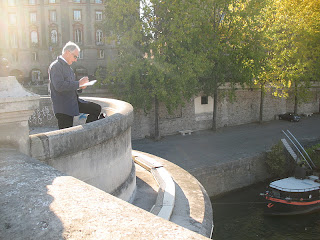From the northern coast we head inland and to the west of the Bretagne peninsula,
up into the hilly region known as the Monts d'Aree,
which is part of a large regional natural park.
In this area is a little town named Huelgoat,
which sits amidst magnificent forests on a serene woodland lake.
We arrive during the the annual food and wine festival, and the town is buzzing.
But later in the day, it becomes eerily quiet.
The town is old and lovely, but it seems like no-one lives here any more.
A beautiful 3 storey building right in the heart of the village,
has a large shop (gallery) and storage area on the ground floor;
2 bedrooms, bathroom, toilet, kitchen and living on the first floor;
3 bedrooms, bathroom, toilet, kitchen and living on the second floor;
and a large loft that could be turned into accommodation
OR
a group of artists studios!
$390,000!
There was a lot of evidence of the Arts,
empty galleries and art schools in grand old buildings,
and an open air ampitheatre in the woods,
but I was told they all move out when it starts to get cold.
Rich pickings for a bunch of artists from Australia to move into and revive the little towns
art and soul.


At the end of the lake are the woodlands.
Enchanted and fairytale like, everything Robin Hood would have dreamed off,
and a Hobbit would die for!
You walk down to the woods through a river gorge filled with huge tumbling granite boulders covered in thick lichens and mosses.
The path leads under rock bridges and down into waterfall caverns.
Light filters through the canopy of elm, birch and maple, and because the season is slowly turning, there is the constant flutter of auburn-brown leaves creating a soft carpet under your feet.


The woods were also the hiding place for the French Resistance during the war,
and there are a number of grave sites dotted along the walk.
In another area there are remnants of a large rampart, dating back to the times of Julius Caesar.
Like the forest, Huelgoat intrigued and enchanted.
But where is the fire?






























































